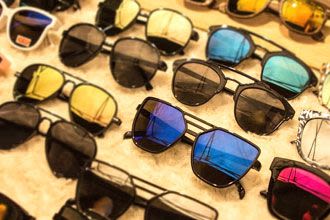Where to buy prescription sunglasses

When you’re ready to shop for prescription sunglasses, it helps to know your options — and the pros and cons of each — before you get started.
Here are four types of places to consider during your quest for the perfect pair of sunglasses:
1. Doctor-affiliated optical shops
You’ve probably bought at least one pair of prescription glasses or sunglasses from this type of store: an optical shop physically connected to or affiliated with your eye doctor’s practice. It’s hard to pass up such a convenient and timely shopping opportunity so soon after getting your eye exam.

Pros: Most likely to have the latest equipment and technology. Very convenient. If you have a concern about your prescription after receiving the lenses, there’s a direct line of communication to the doctor.
Con: Few (if any) specials. Possibly the most expensive option.
2. Stand-alone optical stores
If you want to try frames on in person, a brick-and-mortar optical shop is another great option. Stand-alone stores such as LensCrafters, Pearle Vision and Visionworks often have a large selection of frames online to supplement their on-site inventory, giving you a huge range to choose from.

Pros: Big selection and lots of specials (buy one get one, etc.).
Cons: Another expensive option. Specials might feel more like a way to get prices closer to reasonable costs. Do you really want to buy two pairs of sunglasses to get a great deal?
3. In-store vision centers
You probably buy everything else at Target, Walmart and Costco, so why not prescription sunglasses? Each of these stores has its own optical center where you can get an exam and pick out sunglasses for your new prescription. If you have vision insurance, check each store’s website in advance to determine if that store accepts your plan.

If you’re not a Costco member, you can still get an exam, but you’ll have to join the club for access to all the great deals they have on frames and lenses.
Pros: In-store vision centers accept most insurance plans and frequently have specials on prescription sunglasses and other eyewear. For Costco specifically: Great consumer ratings and big discounts for members.
Cons: In-store vision centers may have fewer lens options or give preference to the store/generic brands rather than offer the latest advances in technology.
4. Online retailers
Online eyewear vendors like EyeBuyDirect cut out the middleman (and don’t have the overhead of those brick-and-mortar stores) to offer prescription sunglasses that match your personality and budget for prices as low as $15.

The beauty of online shopping is that you can quickly compare the styles and prices of different retailers before deciding on a pair of sunglasses. While nearly all providers have some type of satisfaction guarantee, many “e-tailers” also provide style and fit guides, quizzes and chat services to make your online lens purchase as seamless as possible.
Pros: If you have a low-power, simple lens prescription, this could be the quickest, easiest, lowest-cost option.
Cons: It’s hard to tell until you’re checking out just how much extra it will cost for any lens upgrades you want (or need). And, if you have a strong or complex prescription, you may find that some sites aren’t able to fill your order. If you get your sunglasses online, what do you do if you need your frames adjusted?
5 tips for buying prescription sunglasses online

If you’ve weighed your options and decided to shop online, here are five tips to help you get the perfect prescription sunglasses at the best possible price:
1. Know what you need
When you get your prescription from your eye doctor, ask about the best options for you and your vision. Even if you don’t buy your sunglasses from your eye doctor, they can advise you on the types of lenses and frames that should work best for your prescription and needs (e.g., if you’re getting them for a specific activity).
2. Run the numbers
Check your current pair of glasses for the frame measurement on the interior of the temple (arm of the glasses) or inside the bridge. This string of three numbers represents the frame size (horizontal width of each lens), the bridge size (distance between the lenses) and the temple length.
If you have those three numbers, you can look for sunglasses with similar measurements. You also need your prescription and pupillary distance (PD) when ordering online. It’s easiest — and most accurate — to get your PD from your optometrist when you get your prescription.
3. Make wish lists
Noting which sunglasses frames you like is important when making a decision. If the site you’re on has a “favorite” or “wish list” option, click the heart on the styles you like, then go back and compare them when you’re ready to decide.
If a site doesn’t have a way of bookmarking styles you like, you can add frames to your cart (with non-prescription lenses) and compare them there.
4. Use a site’s built-in chat function to ask questions
Sometimes, one of the drawbacks of shopping online is the lack of a knowledgeable salesperson within waving distance. To address that, some online retailers now have representatives standing by to chat with customers. Take advantage of this chat function if you have any questions or concerns before placing your order.
5. Save on your sunglasses
When you’ve found your perfect pair of sunglasses, check the online eyewear retailer’s specials page (or our Eyewear Offers page) and you can likely save on your shades.
Better yet? If you know you’ll be on the hunt for sunglasses in the weeks ahead, sign up for emails from your favorite eyewear retailers to learn about seasonal specials and sales.
Bottom line: Shopping for prescription sunglasses takes time and research, but kicking back and enjoying the result — your perfect pair of shades — is totally worth it.
READY TO SHOP? Best places to buy prescription sunglasses online
Page published on Tuesday, November 19, 2019






